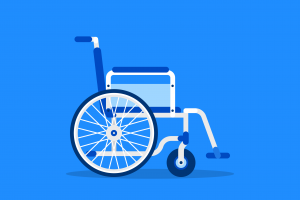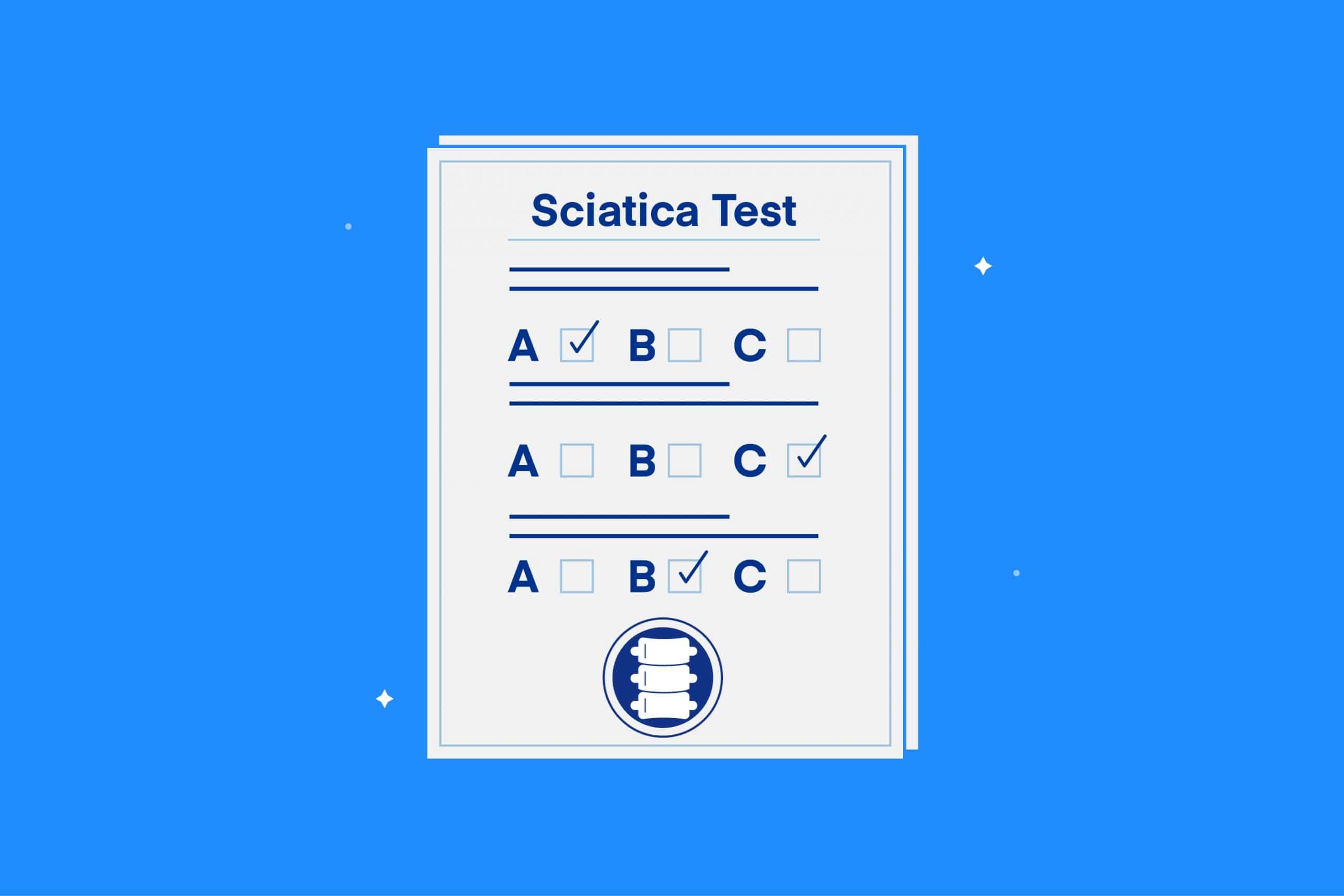Key Takeaways
- Understanding Sciatica: Sciatica is a common condition characterized by intense, sometimes debilitating pain that radiates down the sciatic nerve. It is not a condition itself but a symptom caused by various underlying conditions that pinch the sciatic nerve. While the pain can be severe, it often resolves on its own.
- Diagnosing Sciatica: Sciatica can be diagnosed through physical exams, including at-home tests like the slump test and straight leg raise test. These tests help measure pressure on the sciatic nerve. If you suspect you have sciatica, it’s essential to consult a doctor for a proper diagnosis and potential treatment options.
- Causes and Treatment: Sciatica can result from various causes, including herniated discs, bone spurs, physical trauma, lumbar spinal stenosis, spondylolisthesis, and even pregnancy. Treatment options range from over-the-counter medications, stretching, exercise, hot and cold therapy, physical therapy, to surgery in rare cases. Consult a healthcare professional for guidance on managing and treating your sciatica.
Sciatica is a group of distinct symptoms causing intense, sometimes debilitating pain down the sciatic nerve. According to Harvard Health, Verified Source Harvard Health Blog run by Harvard Medical School offering in-depth guides to better health and articles on medical breakthroughs. View source nearly 40 percent of people experience sciatic pain at some point, and while the pain is severe, the symptoms typically pass on their own.
Sciatica is rather common as it’s a result of different diseases or conditions pinching the sciatic nerve. With the correct diagnosis, the condition can be treated and the pain will eventually subside.
To diagnose sciatica, doctors complete two physical exams to measure the pressure on your sciatic nerve. We share how you can complete these same tests at home and discuss more what sciatica is. If you believe you have sciatica, speak to your doctor about diagnosis and treatment options.
Slump Test
The slump test puts pressure on the spinal cord and peripheral nerves on your lumbar spine.
- Sit upright in a chair without back support.
- Clasp your hands behind your back.
- Slump forward and bring your neck down, touching your chin to your chest.
- Extend one leg forward and flex your foot towards your shin.
- Repeat with the other leg.
If the leg that experiences pain won’t go as high as the unaffected leg or if lifting your leg aggravates your symptoms, you may have sciatica.
Straight Leg Raise Test
The straight leg raise (SLR) test determines the source of your pain. The test stretches the sciatic nerve and, if it’s compressed, the symptoms will occur.
- Lie flat on your back with your legs extended.
- Flex your foot and lift your leg 30 to 70 degrees upwards, keeping your leg straight.
- Repeat with the other leg.
If you experience pain down your leg to your foot or are unable to lift your affected leg as much as the other, this is a positive sciatica test result. If no pain occurs, the test is considered negative and any pain you’re experiencing may be due to other spinal conditions.
Causes of Sciatica
Sciatica itself is not a condition. It’s a symptom of other conditions and creates what is known as referred pain, or pain in one part of the body caused by issues elsewhere.
Herniated Discs
 The most common cause of sciatica is a herniated or slipped disc. Your spinal vertebrae are cushioned by round, gel-like discs, and when these discs are worn down—by age, injuries, or conditions such as degenerative disc disease—their soft interior bulges out and may put pressure on spinal nerves.
The most common cause of sciatica is a herniated or slipped disc. Your spinal vertebrae are cushioned by round, gel-like discs, and when these discs are worn down—by age, injuries, or conditions such as degenerative disc disease—their soft interior bulges out and may put pressure on spinal nerves.
Herniated discs most frequently occur in the lumbar spine, resulting in sciatica. However, if the disc isn’t pressing on any nerves, a person may have no pain at all.
For more, read our guide to the best mattresses for a herniated disc.
Bone Spurs
 The second most common cause of sciatica is bone spurs, or small bone growths. They often develop near joints after damaging the bone and are likely to occur in people with osteoarthritis.
The second most common cause of sciatica is bone spurs, or small bone growths. They often develop near joints after damaging the bone and are likely to occur in people with osteoarthritis.
Most of the time, bone spurs cause little to no symptoms and are only identified after receiving an X-ray. However, if the spur presses against nerves or other bones, including your spine, it puts pressure on the sciatic nerve and causes weakness in your legs.
Physical Trauma
 The trauma from events including vehicular accidents, sports accidents, or improper lifting, can cause nerve damage, herniated discs, and broken bones. The events of physical trauma can pinch the sciatic nerve and lead to pain, even if you have no prior ailments or conditions.
The trauma from events including vehicular accidents, sports accidents, or improper lifting, can cause nerve damage, herniated discs, and broken bones. The events of physical trauma can pinch the sciatic nerve and lead to pain, even if you have no prior ailments or conditions.
Lumbar Spinal Stenosis
 Lumbar spinal stenosis is the narrowing of the spinal canal. Spinal stenosis can happen in any section of the spine, but in regards to sciatic pain, it occurs in the lumbar spine (lower back). With lumbar spinal stenosis, the spinal nerves become compressed and cause sciatica, along with achy calves, and potential loss of mobility.
Lumbar spinal stenosis is the narrowing of the spinal canal. Spinal stenosis can happen in any section of the spine, but in regards to sciatic pain, it occurs in the lumbar spine (lower back). With lumbar spinal stenosis, the spinal nerves become compressed and cause sciatica, along with achy calves, and potential loss of mobility.
The spine weakens with age or due to certain conditions, such as osteoarthritis, herniated discs, or spinal injuries; however, some people are born with a small spinal canal.
Read our guide to the best mattresses for spinal stenosis if you wish to learn more.
Spondylolisthesis
 Spondylolisthesis is a spinal condition where one spinal vertebra slips over another. It’s possible to have little to no symptoms at all, though in some instances, the vertebra compresses nerve roots and leads to sciatic pain.
Spondylolisthesis is a spinal condition where one spinal vertebra slips over another. It’s possible to have little to no symptoms at all, though in some instances, the vertebra compresses nerve roots and leads to sciatic pain.
Spondylolisthesis is common in athletes, older adults, or individuals born with fragile spinal vertebrae. People with spondylolisthesis may experience muscle stiffness, tight hamstrings, difficulty walking and standing, and sharp pain down the buttocks and legs.
Pregnancy
 Sciatic symptoms are common for pregnant women, as 50 to 80 percent of pregnant women struggle with overall back pain. The weight of the growing fetus can put pressure on your pelvis, hips, and sciatic nerve, causing discomfort. After giving birth, the uterus shrinks and the pain should pass.
Sciatic symptoms are common for pregnant women, as 50 to 80 percent of pregnant women struggle with overall back pain. The weight of the growing fetus can put pressure on your pelvis, hips, and sciatic nerve, causing discomfort. After giving birth, the uterus shrinks and the pain should pass.
See also our guide to the best mattresses for pregnancy.
Symptoms to Look Out For
 The sciatic nerve starts at the lower back, through the buttocks, and down each leg, and if it’s pinched, pain occurs in those areas. If you believe you have sciatica, some common symptoms to be aware of include:
The sciatic nerve starts at the lower back, through the buttocks, and down each leg, and if it’s pinched, pain occurs in those areas. If you believe you have sciatica, some common symptoms to be aware of include:
- Lower back pain
- Pain radiating down one or both legs and feet
- Your legs or feet feel weak or numb
- A burning or tingling sensation in your legs and feet
- Pain when standing up or sitting down
- Inability to rest your weight on one leg
- Wobbly knees
When to See A Doctor
 Mild sciatica is typically safe to just remedy at home, but if your pain is worsening or persists beyond a week, it’s best to speak with your doctor. Your doctor will review your medical history and may ask questions such as:
Mild sciatica is typically safe to just remedy at home, but if your pain is worsening or persists beyond a week, it’s best to speak with your doctor. Your doctor will review your medical history and may ask questions such as:
- When did the pain start?
- Where do you feel pain?
- What activities did you do recently?
- Do your legs or feet feel weak or tingly?
Your doctor will likely conduct a slump test and straight leg raise test to check your sciatic nerve pain. They might also conduct imaging tests (X-ray, MRI, or CT scans) to further assess the situation.
If your pain begins suddenly, is caused by an injury or accident, or you experience incontinence (loss of bladder and bowel control), seek immediate medical care.
Sciatica Treatment
Once your doctor determines you do, indeed, have sciatica, they may recommend several different treatment options. Most sciatic symptoms heal after with proper care at home, though in certain cases, you might be referred to a physical therapist or surgeons.
- Medication: You can find over-the-counter NSAIDs (nonsteroidal anti-inflammatory drugs) like aspirin or ibuprofen to ease your pain. However, your doctor might prescribe medications such as anti-seizure medication or muscle relaxants to treat severe sciatica. Your doctor might also provide steroid injections for longer-lasting relief.
- Stretching and exercise: When in motion, inflammation and pain may improve. Light exercise and stretches can reduce irritated nerves, but always ensure you maintain proper form.
- Avoid extended rest: While rest is a good way to ease pain, over-resting can worsen symptoms. It’s best to stay active to keep your muscles strong and, at most, only take one to two days of bed rest.
- Hot and cold treatments: An easy way to temporarily relieve your pain is through hot and cold treatments. Using heat pads, ice packs, topical ointments, or medicated hot and cold patches on any painful areas can reduce symptoms.
- Physical therapy: Your physical therapist teaches you exercises and stretches to relieve pain, improve your posture, and strengthen your muscles. They come up with a treatment and exercise plan you can follow to reduce your symptoms and increase your mobility.
- Surgery: On rare occasions, particularly if your body is not responding to other treatments, surgery may be an option. The main surgical options to treat sciatica are discectomy and laminectomy.

FAQs
Which leg is affected by sciatica?
Sciatica can affect both the legs and buttocks at once, though it typically only affects one side of your body at a time. You have a sciatic nerve on both sides of your body, so the leg affected depends on which side is being pinched or aggravated.
How should I sleep with sciatica?
With sciatica, always use a high-quality mattress and pillows so your body can rest on a proper foundation.
A comfortable position for sciatica is back sleeping with the knees elevated. In this position, any pressure is removed from your lumbar spine and your spine can rest naturally. You can also test side sleeping with a pillow between your knees as it reduces tension from your hips and shoulders and keeps your spine neutral.
Avoid sleeping with your body twisted or on your stomach as both aggravate symptoms.
Dr. Nayantara Santhi says, “Sleep and pain have a two-way relationship. Poor sleep can intensify the pain and conversely, pain can worsen sleep. A good sleeping position can help relieve pain, and a good mattress or pillow can go a long way in facilitating this.”
How long does it take sciatica to heal?
Sciatica can be acute (lasting a few days to weeks) or chronic (lasting longer than 12 weeks). Acute pain episodes can be aggressive, but your sciatica will likely pass on its own. Chronic sciatica is much less severe than acute, but it typically doesn’t respond well to treatment and may become a life-long issue.
What should I avoid doing if I have sciatica?
Avoid putting added pressure onto your lumbar spine and sciatic nerve as much as possible. Activities such as sitting with bad posture, heavy lifting, difficult or strenuous exercise, and sitting or laying down for prolonged periods can aggravate your body.
Be sure not to rest too much when you have sciatica, as your back can weaken and worsen your pain. With this in mind, don’t ignore your pain signals or fight through them. Taking a few minutes to sit down and let your pain pass is perfectly okay.
How do I know if I have sciatica or piriformis syndrome?
Both sciatica and piriformis syndrome cause sciatic nerve pain and have similar symptoms, the causes of the conditions are different.
Piriformis syndrome is caused by anatomic changes in the piriformis muscle. The muscle is located across the femur and outer section of the hips and rotates the hip. The syndrome causes buttock pain or spasms and can irritate and compress the sciatic nerve, leading to sciatic pain. Unlike sciatica, the pain begins in the buttocks, not the lower back.
On the other hand, sciatica is not a syndrome or condition. It’s a variety of symptoms—namely, the sharp pain radiating down one leg, weak legs, lower back pain, and a tingling sensation in the legs and feet—caused by other medical conditions and affects the lower spinal nerves.
Conclusion
Sciatica is typically not a condition to be incredibly concerned about. While it’s painful, it typically goes away on its own and the symptoms may last only a few days to about three months.
Completing these tests at home can verify whether or not you have sciatica or a different spinal condition. At-home remedies are generally enough to ease your pain until your sciatica passes, but if your pain is intensifying, always reach out to your doctor. Diagnosis and treatment are crucial to ensure severe symptoms pass and don’t return.
About the author
Stacy Liman is a journalism graduate student and a freelance writer with a focus on mindfulness and content marketing. Her passion for understanding and writing about the science of sleep enables her to provide valuable insights into achieving healthier and deeper rest. Stacy's commitment to helping people improve their sleep drives her exploration of new mattresses and sleep-promoting gadgets.
View all posts




